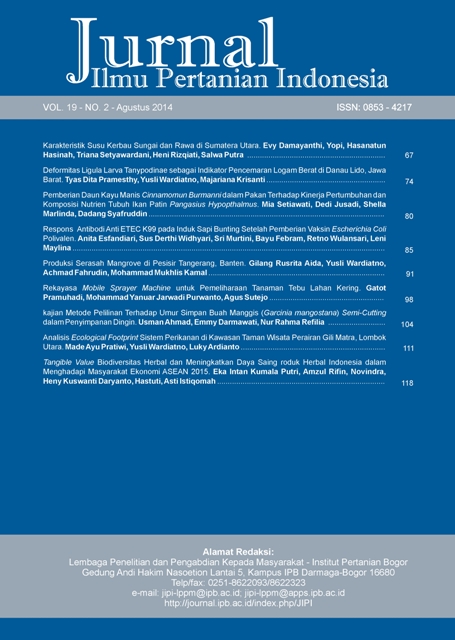Respons Antibodi Anti ETEC K99 pada Induk Sapi Bunting Setelah Pemberian Vaksin Escherichia Coli Polivalen
Abstract
The objective of this experiment was to detect antibody (IgG) against enterotoxigenic Escherichia coli (ETEC)K99 in the blood of cows vaccinated by Escherichia coli polyvalent vaccine. Eight dry cows were injectedsubcutaneously by polyvalent Escherichia coli twice prior to parturition. Before vaccinated, the cows were givenimmunomodulator orally for 3 days. Blood samples were drawn from coccigeal vein prior to the 1st vaccination,two week following the 1st vaccination and at 1, 2, and 4 weeks after the 2nd vaccination. Blood samples wereanalyzed for IgG and ETEC K99 using indirect Enzyme Linked Immunosorbent Assay (ELISA) assay. Results of theexperiment indicated that absorbance values of all vaccinated cows before the first vaccination until third weekfollowing the 2nd vaccination were below cut off values. The absorbance values then increased and were above cutoff values at fourth week following the 2nd vaccination. In conclusion, antibody against ETEC K99, were detected inthe blood of cows, fourth week following the 2nd vaccination.
Downloads
References
Aldridge B, Garry F, Adams R. 1992. Role of colostral transfer in neonatal calf management: Failure of acquisition of passive immunity. Compendium on Continuing Education for the Practising Veterinarian. 14: 265-270.
Barrington GM, McFadden TB, Huyler MT, Besser TE. 2001. Regulation of colostrogenesis in cattle. Livestock Production Science. 70: 95-104.
Behn I, Hommel U, Oertel M, Hauschild S. 1996. Kinetics of IgY formation after immunisation of hens with different protein antigens. ALTEX. 13(5): 18-21.
Butler JE. 1983. Bovine immunoglobulin: An augmented review. Veterinary Immunology and Immunopathology. 4: 43-152.
Carlander D. 2002. Avian IgY antibody. in vitro and in vivo. Dissertations. Canada: Acta Universitatis Upsaliensis. Uppsala (SE).
Chang HM, Ou-Yang RF, Chen YT, Chen CC. 1999. Productivity and some properties of immunoglobulin specific against streptococcus mutansserotype C in chicken egg yolk (IgY). Journal of agricultural and food chemistry. 47(1): 61-66.
Chase C. 2012. How to Get the Most Out of your Vaccination Program. Proceedings Applied Reproductive Strategies in Beef Cattle December 3-4, 2012, Sioux Falls (US), SD 301. Pp 1-8.
Constantine NT, Callahan JD, Watts DM. 1992. Retroviral Testing. London (GB). CRC Press.
Elfstrand L, Mansson HL, Paulsson M, Nyberg L, Akesson B. 2002. Immunoglobulins, growth factors, and growth hormone in bovine colostrums and the effects of processing. International Dairy Journal. 12(11): 879-887.
Esfandiari A, Wibawan IWT, Wulansari R, Murtini S. 2008a. Produksi Kolostrum Anti Enteropatogen Spesifik dalam Rangka Imunoterapi Pasif Guna Mencegah Kematian Neonatal Akibat Diare. Laporan Penelitian Hibah Bersaing XIV/2. Lembaga Penelitian dan Pemberdayaan Masyarakat, Institut Pertanian Bogor (ID).
Esfandiari A, Wibawan IWT, Murtini S, Widhyari SD. 2008b. Produksi Kolostrum Anti Virus Avian Influenza dalam Rangka Pengendalian Infeksi Virus Flu Burung. Jurnal Ilmu Pertanian Indonesia. 13(2): 69-79.
Esfandiari A, Widhyari SD, Hujarat A. 2011. Diare pada Sapi Neonatus yang ditantang Escherichia coli K-99. Jurnal Ilmu Pertanian Indonesia. 16(3): 191-197.
Hill K. 2011. Colostrogenesis: Timing is everything. http://www.progressivecattle.com/focustopics/herd-health/September, 28.
Kreier JP, Mortenseng RF. 1990. Infection, Resistance, and Immunity. New York (US): Harper and Row.
Kresno SB. 2001. Imunologi: Diagnosis dan Prosedur Laboratorium. Edisi ke-4. Balai Penerbit Fakultas Kedokteran Universitas Indonesia. Jakarta (ID). Hlm. 437.
Kuby J. 1997. Immunology. Ed ke -3. New York W.H. Freeman and Co (US).
Larson BL, Heary HL, Devery JE. 1980. Immunoglobulin production and transport by the mammary gland. Journal of Dairy Science. 63(4): 665-671.
Larson BL. 1992. Immunoglobulin of the Mammary Secretions. In: Fox PF, editor. Advanced Dairy Chemistry Vol I: Advanced Dairy Chemistry-1: Proteins. Great Britain: Elsevier Science Publishers LTD. Page 231.
Liddell E, Weeks I. 1995. Antibody Technology. BIOS Bioscience Publisher Limited (GB).
Lona DV, Romero RC. 2001. Short communication: Low levels of colostral immunoglobulins in some dairy cows with placental retention. Journal of Dairy Science. 84(2): 389-391.
Makvandi M, Fiuzi R. 2002. Purification of anti-HbsAg from egg yolks of immunized hens and its application for detection of HbsAg. Archives of Iranian medicine. 5(2): 91-93.
Mellor D. 1990. Meeting colostrum needs of newborn lambs. In Practice. 12(6): 239-244.
Oyeniyi OO, Hunter AG. 1978. Colostral constituents including immunoglobulins in the first three milkings postpartum. Journal of Dairy Science. 61(1): 44-48.
Perino LJ. 1997. A guide to colostrums management in beef cows and calves. Veterinary Medicine. 92(1): 75-82.
Smith JR. 1995. Produksi Serum Hiperimun. Di dalam: Artama WT, penerjemah; Burgess GW, editor. Teknologi ELISA dalam Diagnosis dan Penelitian. Yogyakarta (ID): Gadjah Mada Univ Pr. Hlm 15-32.
Supar. 1986. Penggunaan Enzyme-Linked Immunosorbent Assay (ELISA) untuk Deteksi Antigen Pili K99, K88 pada Escherichia coli dari Anak Sapi dan Anak Babi Diare. Penyakit Hewan 17: 159-168.
Supar. 2001. Pemberdayaan Plasma Nutfah Mikroba Veteriner dalam Pengembangan Peternakan: Harapan Vaksin Escherichia coli Enterotoxigenic, Enteropatogenik dan Verotoksigenik isolat lokal untuk Pengendalian Kolibasilosis Neonatal pada Anak Babi dan Sapi. Wartazoa 11: 33-43.
Tizard I. 2000. Veterinary Immunology an Introduction. Philadelphia (US): WB Saunders Company.
Utomo B, Prawirodigdo S, Sarjana, Sudjatmogo. 2006. Performan Pedet Sapi Perah dengan Perlakuan Induk Saat Masa Akhir. Di dalam Prosiding seminar Nasional Teknologi Peternakan dan Veteriner 2006. Bogor (ID): Pusat Penelitian dan Pengembangan Peternakan. Hlm 76-81.
Waterman D. 1998. Colostrum. The beginning of a successful calf raising program. Http://www.moormans.com/dairy/DairyFF/dairymar98/ colostrum. htm. February, 28.
Wibawan IWT, Pasaribu FH, Utama IH, Laemmler C. 1999. The role of hyaluronic acid capsular material of Streptoccocus equi subsp.zooepidemicus in mediating adherence to HeLa cells and resist phagocytosis. Research in Veterinary Science. 67: 131-135.
This journal is published under the terms of the Creative Commons Attribution-NonCommercial 4.0 International License. Authors who publish with this journal agree to the following terms: Authors retain copyright and grant the journal right of first publication with the work simultaneously licensed under a Creative Commons Attribution-NonCommercial 4.0 International License. Attribution — You must give appropriate credit, provide a link to the license, and indicate if changes were made. You may do so in any reasonable manner, but not in any way that suggests the licensor endorses you or your use. NonCommercial — You may not use the material for commercial purposes.


















